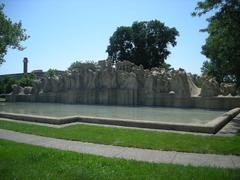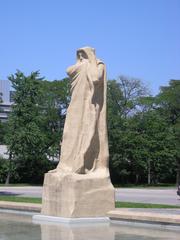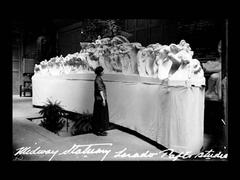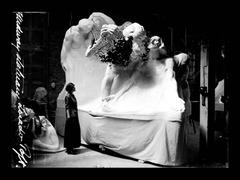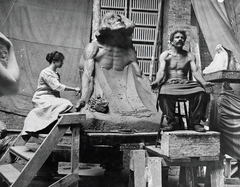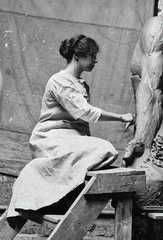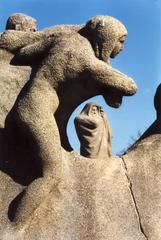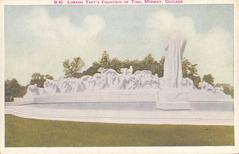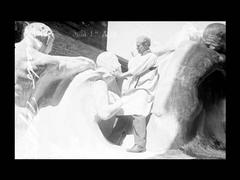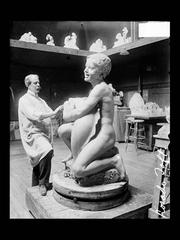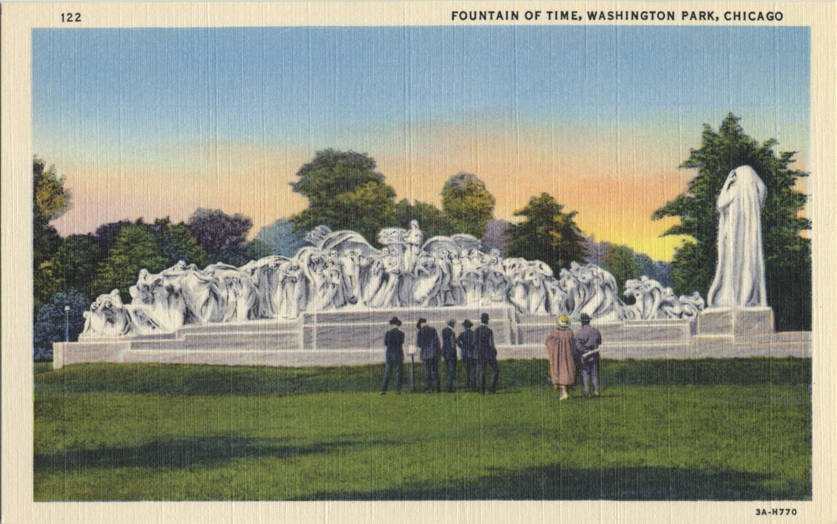
Fountain of Time Chicago: Visiting Hours, Tickets, and Historical Sites Guide
Date: 15/06/2025
Introduction
The Fountain of Time, located on Chicago’s historic South Side, is one of the city’s most significant public art monuments. Conceived by renowned sculptor Lorado Taft, this monumental concrete sculpture stands as a tribute to the passage of time and the enduring spirit of peace. Spanning over 100 human figures parading before the imposing figure of Father Time, the fountain embodies the city’s cultural ambition and commitment to beautifying public spaces with deeply symbolic art (artandarchitecture-sf.com, atlasobscura.com, EverGreene Architectural Arts).
This comprehensive guide provides everything you need to know for an enriching visit, including the sculpture’s history, artistic significance, visiting hours, accessibility, directions, nearby attractions, and travel tips.
Historical Background and Significance
Origins and Context
The Fountain of Time was conceived as part of the early 20th-century City Beautiful movement, aiming to uplift urban environments through public art. Funded by the Benjamin Ferguson Trust—established in 1905 to commemorate a century of peace following the War of 1812—the fountain is both a historical marker and an artistic innovation (artandarchitecture-sf.com, atlasobscura.com). Its location at the western edge of the Midway Plaisance in Washington Park places it at a significant junction in Chicago’s park system, connecting Washington Park to Jackson Park.
Lorado Taft’s Vision
Lorado Taft, educated at the University of Illinois and the École des Beaux-Arts in Paris, envisioned the fountain as a grand procession of humanity, inspired by Henry Austin Dobson’s poem: “Time goes, you say? Ah no, Alas, time stays, we go.” The figures, ranging from childhood to old age, march before Father Time, reflecting on the universal journey of life and mortality. Taft also included subtle personal touches, such as a self-portrait within the procession (artandarchitecture-sf.com).
Design, Materials, and Construction
Innovative Techniques
Originally planned for marble or granite, budget constraints led to the pioneering use of steel-reinforced cast concrete. This material allowed for the creation of 100+ detailed figures across a 126-foot-long sculpture, molded from more than 4,500 pieces and weighing 230 tons (atlasobscura.com, EverGreene Architectural Arts). The surface features exposed aggregate—pebbles from the Potomac River—imbuing the work with a unique texture and resilience.
Conservation and Restoration
Despite its innovation, the fountain’s concrete and steel construction proved vulnerable to Chicago’s harsh climate. By the late 20th century, deterioration necessitated a major restoration, completed in 2005. This process included structural stabilization, gentle cleaning, replacement of damaged materials, and ongoing monitoring to preserve the monument’s integrity (EverGreene Architectural Arts).
Artistic Symbolism
The Fountain of Time’s panoramic frieze depicts the diversity of human experience, with figures representing all ages and walks of life. Father Time, hooded and holding a scythe, presides over the procession—a stirring meditation on the fleeting nature of existence. The monument’s scale, classical composition, and allegorical power have influenced generations of artists and continue to inspire contemplation (artandarchitecture-sf.com, Hyde Park History).
Visiting Hours and Tickets
- Open: Year-round, outdoors, and accessible from dawn to dusk.
- Admission: Free; no tickets are required for entry.
- Best Time to Visit: Spring and summer, when the reflecting pool is filled and the surrounding park is lush; daylight hours provide optimal viewing and safety (Chicago Park District, Traveler Lifes).
Location and Directions
- Address: 6000 Cottage Grove Avenue (sometimes listed as 5530 S. Cottage Grove), at the western end of the Midway Plaisance in Washington Park, Chicago, IL 60637.
- Public Transit: CTA #4 Cottage Grove bus stops nearby; CTA Green Line (Garfield station) is within walking distance; Metra 59th Street/University of Chicago station is also accessible.
- Parking: Limited street and public lot parking are available within Washington Park; public transportation is recommended during peak times (Chicago Park District).
Accessibility
- Wheelchair Access: Paved, level paths provide easy access for wheelchairs and strollers.
- Amenities: Benches and shaded areas for rest; accessible restrooms within Washington Park, though not adjacent to the sculpture (Chicago Park District).
- Sensory Experience: Visitors can enjoy the reflecting pool (seasonal), textured surfaces, and the changing natural backdrop.
Nearby Attractions
- University of Chicago Campus: Historic architecture and public art within walking distance.
- Midway Plaisance: Landscaped green corridor connecting Washington and Jackson Parks.
- Museum of Science and Industry & DuSable Museum of African American History: Short transit or driving distance.
- Garfield Park Conservatory & Hyde Park Dining: Additional cultural and culinary experiences (Traveler Lifes).
Guided Tours and Educational Programs
- Local Tours: Offered occasionally by the Hyde Park Historical Society, Chicago Movie Tours, and University of Chicago arts programs (Hyde Park History, Chicago Movie Tours).
- Educational Value: The monument is used in art and history curricula and featured in interpretive signage on-site.
Visitor Experience and Tips
- Photography: Panoramic shots are best in early morning or late afternoon light; wide-angle lenses capture the full frieze.
- Best Seasons: Spring and summer for the reflecting pool and vibrant landscape; autumn for dramatic foliage.
- Amenities: Bring water and snacks; public restrooms are elsewhere in the park.
- Safety: The park is generally safe during daylight; standard urban precautions are recommended.
Conservation and Community Engagement
The Fountain of Time has benefited from community advocacy and major restoration projects, including a $2 million campaign completed in 2007, supported by public and private funding (Chicago Park District). Ongoing preservation ensures the sculpture remains safe and accessible for future generations.
Cultural and Media Impact
The fountain’s allegorical depth and striking visual presence have led to appearances in films such as “Flatliners” (1990) and “The Package” (1989), as well as documentaries about Chicago. Its integration into the city’s urban narrative and its frequent inclusion in walking tours underscore its enduring influence (Chicago Movie Tours).
Frequently Asked Questions (FAQ)
Q: What are the Fountain of Time’s visiting hours?
A: The monument is outdoors and accessible daily from dawn to dusk, year-round.
Q: Is there an admission fee or ticket required?
A: No, visiting the Fountain of Time is free.
Q: Is the site wheelchair accessible?
A: Yes, paved paths and accessible park facilities are available.
Q: Are guided tours available?
A: Guided tours are occasionally offered by local organizations; check with the Chicago Park District or Hyde Park Historical Society for current schedules.
Q: What are nearby attractions?
A: The University of Chicago, Museum of Science and Industry, Midway Plaisance, and DuSable Museum are all nearby.
Visuals and Media
Visitors are encouraged to take photos and share their experiences. For virtual exploration, consult EverGreene Architectural Arts and Chicago Park District for high-quality images and digital resources.
Travel Tips
- Visit during daylight for optimal views and safety.
- Combine your trip with other South Side attractions.
- Check weather conditions and park event calendars before your visit.
- Use public transit for convenience, especially during weekends or events.
Conclusion and Call to Action
The Fountain of Time is a must-see for anyone interested in Chicago’s rich artistic, historical, and cultural heritage. Its grand scale, allegorical depth, and innovative design make it a standout destination—freely accessible and open to all. Plan your visit for spring or summer to experience the monument at its most vibrant, and don’t miss the chance to explore the surrounding Washington Park and Hyde Park neighborhoods.
For more detailed directions, special events, and audio-guided tours, download the Audiala app. Stay connected on social media for the latest updates on Chicago historical sites and public art. Discover related articles to expand your exploration of the city’s landmarks.
References
- Fountain of Time Chicago: Visiting Hours, Tickets, History, and Visitor Guide (artandarchitecture-sf.com)
- Fountain of Time Chicago: Visiting Hours, History, Materials, and Restoration Guide (EverGreene Architectural Arts)
- Fountain of Time Visiting Hours, Tickets, and Guide to Chicago’s Historic South Side Monument (Chicago Park District)
- Fountain of Time Chicago: Visiting Hours, Tickets, and Cultural Significance (Hyde Park History)
- Fountain of Time Chicago: Visiting Hours, Tickets, and Cultural Significance (Chicago Movie Tours)
- Fountain of Time Chicago: Visiting Hours, Tickets, History, and Visitor Guide (atlasobscura.com)

